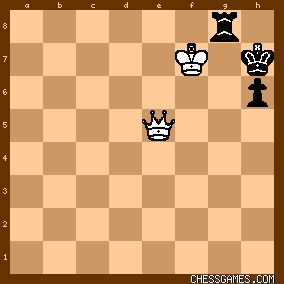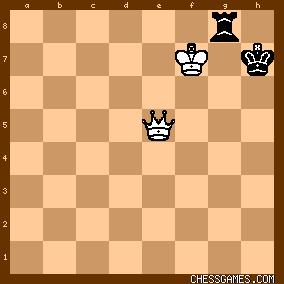|
< Earlier Kibitzing · PAGE 3 OF 3 ·
Later Kibitzing> |
| Apr-25-05 | | Ziggurat: Sounds like good fun. Could you tell us a bit more how your algorithm works? For instance, which positions are considered to be relevant? |
|
| Apr-25-05 | | Gypsy: <independentthinker> Such a scheme is intriguing on its own, even if the games may not be. |
|
| Apr-25-05 | | independentthinker: ziggurat - well I have used middlegame positions taken from games (both won and lost) by the players during their 3 year peaks (as per the chess stats website). I have decided to avoid openings and endgames. If this were real the players would themselves go in and 'prepare' and there is no way I would be able to simulate that. Likewise, sometimes players blunder and make unusual moves in the endgame, whereas the machine tends to play it very well. I could never simulate that. My best chance (I believed) was to go with middlegame positions where a player tries to stamp their style of play on the game. My algorithms are nothing more than artificial neural networks that have been trained on the test sets mentioned. They are given the most reasonable moves by fritz, as well as the correct move made by the player at the time if that is not one of the top 10 moves fritz finds. It's all stuff any CS undergraduate could do, so nothing super advanced or cutting edge. |
|
| Apr-25-05 | | Ziggurat: Thanks for the description, <independentthinker>. I'm actually right now preparing a lab session on artificial neural networks (I'm a teaching assistant in computer science) so I was curious if that was what you used. |
|
| Apr-25-05 | | independentthinker: Can you think of anything we could do to enhance this? I thought maybe finding one GM to study each of the contenders, then having them work alongside the system to pick the most suitable move? |
|
| Apr-25-05 | | YouRang: Rg8+ was pretty obvious. I tried to find a "clear" winning line for white afterwards (e.g. capture the rook) but didn't see any. Once I looked at the game, it became evident that Rg8+ was as far as we were expected to go. |
|
| Apr-25-05 | | kevin86: This is a funny Monday puzzle:If the solution is to sac the rook and then queen-it is easy. However,as it states,the solution to win involves a very complicated Queen vs Rook and Pawn ending-so that aspect is more that of a midweek puzzle. With best play-and not against Karpov,the Romanian should draw. So maybe,we have a bogus puzzle. |
|
| Apr-25-05 | | aw1988: This being Monday for one, I think just Rh8+ is sufficient, knowing it's won. |
|
| Apr-25-05 | | Ramin: That's true Kevin86, if black keeps the rook on the F file, it's a dead draw. Roman Dzindzichashvili talks about this end game in his chess ending dvd. |
|
| Apr-25-05 | | bassplayer: I'm new at this. I got the rook sac easily and the next few moves before getting lost. But, it's my first Monday puzzle. Enjoyed the game. Looking forward to tomorrow's puzzle. |
|
| Apr-25-05 | | aw1988: <chessgames> I hope I'm right on this, but in case I'm not, feel free to correct; there seems to be some confusion about this one. What do we have to get for the Monday puzzle to count in this case? |
|
| Apr-25-05 | | Rank Amateur: I found 40 Rh8+ and the next few moves. Not the next 25 or so. I count that as solving the puzzle. But I wonder about backing it up a little bit. What if we were asked to find white's 38th move. Does white force the same result? |
|
| Apr-25-05 | | patzer2: White's 42. Qc7+! allows him to win the Bishop via a series of clever double attacks. Without this move, White has no chance of winning. As <The Beginner> notes above, Black's 59...Kg8? is an apparent mistake, since 59...Rg7 or 59...Rg8 appear to hold. However, 60. Qe6+! is instructive in showing how to exploit the mistake: <59. Qe4 Kg8?> This loses. Black can draw with 59...Rg8! or 59...Rg7!
<60. Qe6+ Kh7 61. Kf7 Rg8 62. Qf5+ Kh8 63. Qe5+ Kh7 64. Qe6> Had Black not resigned here, Play might have continued 64...Rg5 (64... Rg7+ 65. Kf8 h5 66. Qe5 Rg8+ 67. Kf7 Rg6
68. Qf5  ) 65. Kf8 h5 66. Qf7+ Kh6 67. Qf6+ Rg6 68. Qf4+ Kh7 69. Qe4 Kh6 70. Kf7 Rg7+ 71. Kf6 Rg4 72. Qf5 Rg8 73. Qf4+ Kh7 74. Qe5 Kh6 75. Kf7 h4 76. Qf4+
Kh5 77. Kxg8 ) 65. Kf8 h5 66. Qf7+ Kh6 67. Qf6+ Rg6 68. Qf4+ Kh7 69. Qe4 Kh6 70. Kf7 Rg7+ 71. Kf6 Rg4 72. Qf5 Rg8 73. Qf4+ Kh7 74. Qe5 Kh6 75. Kf7 h4 76. Qf4+
Kh5 77. Kxg8  1-0 1-0
|
|
| Apr-25-05 | | Castle In The Sky: The initial ♖h8 is fairly easy, but the rest is for the grandmaster. |
|
| Apr-25-05 | | tjshann: Monday, Monday...can't trust that day.
"White to play and win"--in 24 moves.
The first move is obvious, the rest not so. As patzer2 points out, this could have gone on another 13 moves if Black hadn't finally thrown in the towel. |
|
| Apr-25-05 | | RookFile: But it's not a win, it's only a draw
with best play. |
|
| Apr-25-05 | | Gypsy: It is hard to believe that, right after the 48.Qxe6+, White would have no more than a draw with the best play. But the Tablebase oracle claims a draw after the 55.Qxh3. Of course, the natural question to ask then is how to proceed differently. When the Q is white, the two old-endgame-manual <Q vs R+P> rules applicable here are: (1) g-pawn saves the game for Black; while (2) White has a forced win against the pawn at h7, h5, or h4 pawn. (In the rest of the cases, it depends.) |
|
| Apr-25-05 | | chess man: Quite easy. But it should be because it's Monday. |
|
| Apr-25-05 | | white pawn: Great game. I got the puzzle, along with the continuation! |
|
| Apr-25-05 | | artemis: The early puzzles are just thematic. Other moves for white are in black's favor. This move is to rook endgames what a simple Bxh7+ sacrifice is to a middle game, so the Rh8+ is an appropriate find for thie puzzle. |
|
| Apr-25-05 | | THE pawn: Rh8+. |
|
| Apr-25-05 | | brianj: Ahh, that was fairly understandable. |
|
Apr-25-05
 | | Richard Taylor: <anyone re endgames?> I missed this except the first move -but if Blacks' peices KR and pawn were more central is that usally a draw ?? I think Rueben Fine assesses it so - although Chess is so intricate one can only 'assess' -looking at both Keene (Bronstein) and Karpov's games there were endgemes to condsider - Karpov is a great endgame player -a great player - so is Bronstein and Keene is great - brilliant anycase - the combo for Bornstein hinges on a won ending which for Patzers like me doesnt arise as much as Q v R and K is more common than knight v bishop -or is more common for me -I know I a pretty good with R and pawn (but they can be intricate and deceptive!!) but sometimes I just cant see why an ending is won eg B v Knight - be good Karpov's games are really worth studying -they are beautiful like Capablanca's or Rubinstein's -of course not all his games -but very many if Keene put on that position showing
how to win as White - I suppose i could run it past my computer Chessmaster - hadnt thought of that...hmmm...some thoughts from an old brain in a dry season
Again - the key is to enjoy and or learn from the moves not to mecessarily work all moves out or solve everything (if you are of course you (one) are (is) doing greatly) <Gypsy> as partly answered my question(s) i see - thanks |
|
Apr-25-05
 | | Richard Taylor: <chess man> in Kiwiland its Tuesday --please be precise |
|
Feb-20-12
 | | Peligroso Patzer: The position after <63. … Kh7>, as follows: 
click for larger view ... is instructive. Here, <64. Qf6> would have been another winning move, but only because after <64. … Rf8+ 65. Kxf8>, Black would have <65. … h5>. In the hypothetical position without the h-pawn: 
click for larger view… it is one of the well-known finesses of pawnless Q vs. R endings that <1. Qf6?> is a blunder allowing <1. … Rf8+! 2. Kxf8> with a draw by stalemate: 
click for larger view |
|
 |
 |
|
< Earlier Kibitzing · PAGE 3 OF 3 ·
Later Kibitzing> |





